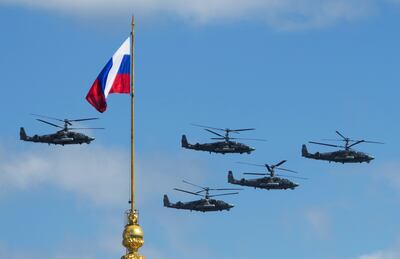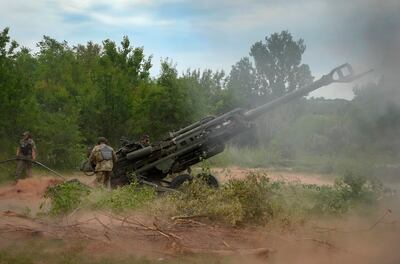Russia has lost almost a third of its crucial attack helicopters that have proven deadly against western-supplied tanks, with military analysts suggesting that the British-made Starstreak missile is having an impact.
The use of US-supplied cluster munitions is also having a devastating effect on Russian lines, with Moscow military bloggers suggesting they “shamelessly mow down fighters” causing a “very painful and terrible death”.
The two weapons are likely to have played a significant role in advances in south-east Ukraine this week which saw them take the Russian strongholds of the small towns of Urozhaine and Robotyne.
It now appears that Russian lines are coming under pressure, with the growing possibility that the Ukrainians could achieve a breakout to the Sea of Azov, about 70km distance. This would achieve Kyiv’s key summer offensive objective of cutting Russia’s army in two and suppressing the Crimea peninsula.
“Recent Ukrainian advances may be significantly weakening confidence in the Russian defence along the wider front in southern Ukraine,” the Institute for the Study of War think tank stated on Friday.
Ukraine is also set to further strengthen its forces with the announcement on Friday that the US would allow Denmark and the Netherlands to send up to 50 F-16 fighters to Kyiv.
Alligator down
There will be growing concern among Moscow’s generals that their stockpile of Ka-52 attack helicopters is diminishing.
Last year, they had 133 on their inventory but according to the Oryx website, which records military equipment losses, they lost 40, plus another three this week.
The twin-rotor Ka-52 Alligator has been compared to the American Apache and has proved particularly effective in defence, hovering above tree lines to fire at Ukraine’s modern armour.

It carries 12 Vortex anti-tank missiles that have a range of 8km and whose laser guidance systems are near jam-proof.
But it appears the Ukrainians have ensured that their troops on the front lines are equipped with effective air defence missiles, potentially with the Starstreak missiles.
Previously Ukraine had to use several air defence missiles to destroy a Ka-52 after forcing them to use up their countermeasures, said Sam Cranny-Evans, an associate at the Rusi think tank.
“It was not completely straightforward to shoot them down, but the recent losses indicate that the Ukrainians have got air defence in position where they can hold that type of asset at risk.
“Starstreak is also particularly effective against helicopters, assuming that the operator is well trained.”
He also pointed to Soviet-era systems such as the Strela missile that were also highly capable alongside other western systems.

The Ka-52s had proven “hugely effective” and the Ukrainians had experienced “troubles taking them down”, said Col Hamish de Breton, a former British tank regiment commanding officer.
“So taking three down in the last few days is hugely significant.”
Three were lost on Thursday and one at the weekend.
With the helicopters hovering some distance away, it appears that the Ukrainians have developed a method of identifying them, potentially with drones.
ISW also suggested that pilot fatigue was playing a part. “The destruction of two Ka-52s in the same day could indicate that protracted Russian aviation operations without rest may be degrading Russia’s limited cadre of pilots.”
The helicopter loss is also significant because if there was any breakthrough of the main defensive lines, they would be deployed to halt the advance by destroying the tank spearhead.
Starstreak power
Among all the western air defence missiles, the British-made Starstreak has gained a reputation for its effectiveness in downing aircraft.
“It's not an accident Russia is suffering because taking down helicopters is what Starstreak was designed for,” said Col de Breton Gordon.
Travelling at 3,700kph, three times the speed of sound, Starstreak is 160kph quicker than the American Stinger missiles, giving pilots very little reaction time.
More importantly, it is not heat seeking but radar guided on to the target by the gunner.

Furthermore, instead of one warhead, it has three tungsten darts that embed in the target before exploding.
They have a range of about 7km, meaning that Russian helicopters might have strayed too close, although being man-portable means that they can be right on the front line.
Their combat effectiveness has led Britain to restart the Starstreak production line that was shut down in 2012.
Cluster devastation
The deployment of American-made cluster artillery rounds appears to be having another major impact.
A Russian military blogger called “Colonel Shuvalov”, who has previously reported accurately on battlefield developments, described their devastating effect on a Telegram post.
“It is impossible not to take into account the factor of modern western cluster munitions – they shamelessly mow down fighters at the front,” he wrote.
The wounds from cluster munitions “often result in death” he said, and added: “Guys on the front line are taking the beating.”
The DPICM, or Dual Purpose Improved Conventional Munition, artillery shell contains 42 bomblets that disperses over an area half the size of a football pitch, each detonating on impact like an individual hand grenade.

They are much more effective than individual artillery rounds when used against defensive systems as they ensure a number enter trench systems.
“If you're in a trench, you're pretty much going to be OK if a high explosive artillery round lands a short distance away, but for cluster, that same size of artillery round carries hundreds of munitions that are very difficult to hide from,” said Col de Breton Gordon.
“Terrible agony”
The Ukrainians were using cluster bombs to cut off reinforcements or withdrawals, with one graphic video showing scores of retreating Russian soldiers mown down south of Urozhaine.
“You can’t save yourself with a bandage or a tourniquet, after being hit with cluster munitions you need solid medical care,” wrote Colonel Shuvalov.
“In the trenches, a terrible mess is formed from the living and the dying, who are sometimes completely impossible to help.

“It is not some colonel in a hospital bed that is yelling about the cluster munitions – the voices of hundreds of guys dying in terrible agony in the trenches.
“The cluster situation is terrible, and worst of all, we try to silence the problem when we need a solution.”
He added that the Russians had insufficient counter-battery fire to answer the threat.
The pressure is likely to intensify on Russian lines in the coming weeks after Ukraine advances have allowed them to operate in the areas past the densest minefields.
“The further degradation of Russian forces creates opportunities for any Ukrainian breakthrough to be potentially operationally significant,” the ISW reported.





